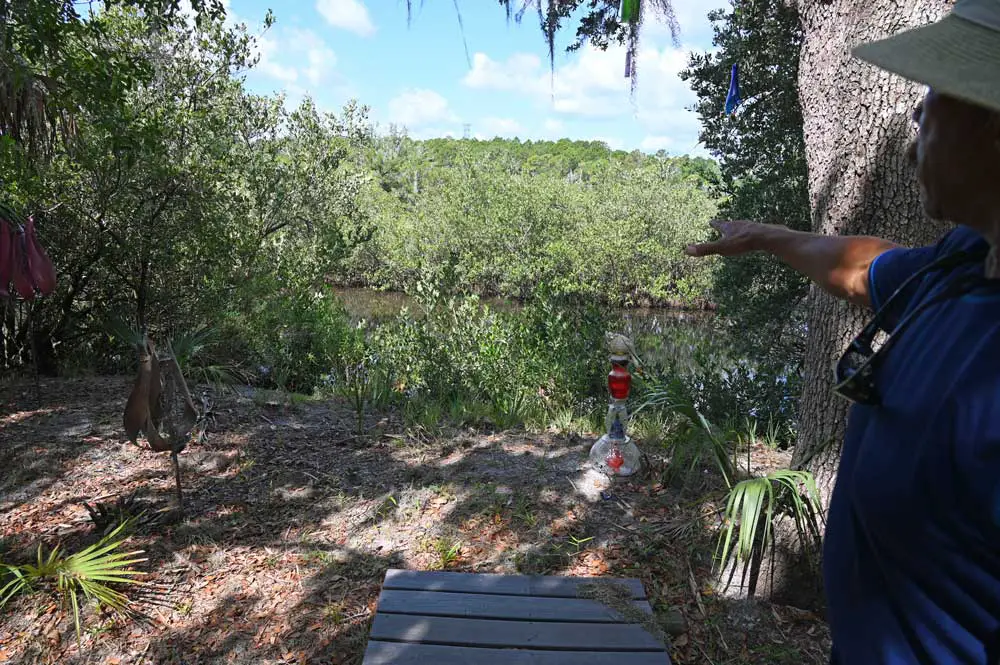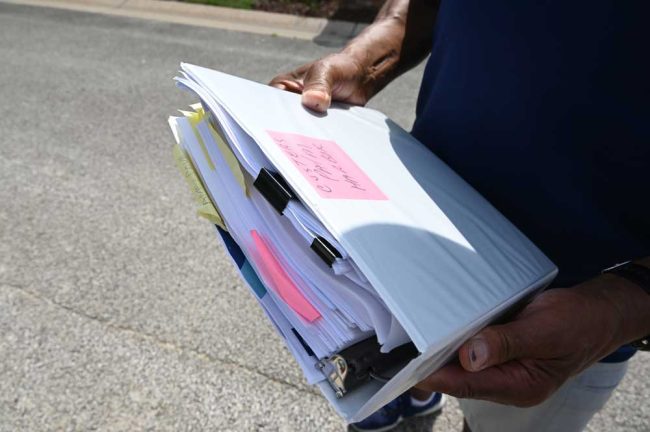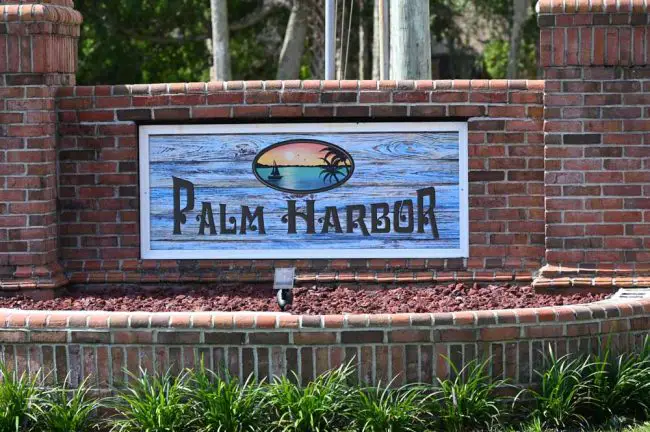
Just before the Flagler County Commission voted earlier this month to clear another hurdle in the path of the Veranda Bay development–formerly known as The Gardens–on John Anderson Highway near Flagler Beach, Michael Chiumento, the attorney representing veranda, addressed one of the main concerns from neighboring residents: flooding along nearby Palm Drive.
“The city of Flagler Beach has done their study to look at what’s causing the flooding on Palm Drive and it’s not us,” Chiumento said, “it’s a dysfunctional stormwater system that they have on Palm Drive that has not been maintained by that association.”
Chiumento was only half right: the city studied the matter, and what flooding there is on Palm Drive is not being caused by the vast acreage set for Veranda’s development, especially since not a single home has yet been built there. But the attorney was, through no fault of his own, incorrect about a stormwater system that had not been maintained by a homeowners’ association.
There is no such association on Palm Drive. But even Flagler Beach government didn’t know it until recently–or at least acted as if it didn’t know it: if there’d been no maintenance of the stormwater system there, it’s because the city assumed there was a homeowners association. The city was leaving it to that ghost entity to maintain the system. So it never was maintained.
That history is key, both in understanding some of the tensions between residents worried about flooding from the future development–on Palm Drive’s Palm Harbor and Custers Palm Harbor neighborhoods–and in placing the responsibility for what flooding has been happening on the right entity: the city, which has now acknowledged its role in catching up to that responsibility.
The Gardens/Veranda is not within Flagler Beach city limits. It merely skirts those limits. It’s in unincorporated Flagler County, so it falls under county government land use regulations. That has further complicated and confused the matter, since Flagler Beach attempted last year to have a set of land use conditions attached to the development, but the county commission declined to go along.

It doesn’t mean Veranda is off the hook. There are still real concerns about what the big development, starting with 56 homes and growing to over 330 in future phases, might do to water flows. The development’s boundaries dwarf Palm Drive. Even the county commission approved the latest regulatory step, Commissioner Greg Hansen raised concerns about flood waters from Veranda. “The water goes where water goes, and it’s kind of downhill, and downhill goes right to Palm Avenue and Palm Drive. So that bothers me,” Hansen said before the vote two weeks ago. “And I think there needs to be some way in this whole negotiation that we can hold this development’s feet to the fire on drainage, because I just I don’t see it.”
But City Commissioner Ken Bryan, who had been part of a group opposing the development but has come around to accepting it in its scaled back (and inevitable) form, is comfortable with Veranda’s assurances, because they’re backed up by the city’s consultants.
“That makes me comfortable because we’d hired another firm to do that,” Bryan said of Mead and Hunt, the Port Orange construction and engineering consultants. “We’re going to try to do all we can to get on the same page for the benefit of the community.”
So it was left up to Bryan, who lives on Palm Drive–and knew of the non-existence of the association–to spend untold hours researching minutes and other city documents to figure out how the myth of a homeowners association took on the bearings of something real. His research adds up to five inches of documents in a three-ring binder, including references in city-commissioned stormwater studies by Mead and Hunt: “This is a private subdivision with privately owned streets and storwater system” a Mead and Hunt study about its Palm Drive recommendations from not long ago read. “The City has received inquiries from residents who have concerns with a proposed development that will be located to the west of the subject development. The residents’ concern is with the possibility of increased flooding due to discharges or blockages of flow caused by the proposed development.”

Mead and Hunt’s latest document, an April 22 technical memo, still in draft form when obtained by FlaglerLive, has corrected the misconception. Its recommendations now directly address city responsibilities: “It is recommended that the City Attorney oversee any easement and/or property acquisition, along with notification and coordination with existing permittee and property owners,” the consultants conclude, regarding the Palm Harbor water system along palm Drive. “Mead & Hunt developed a scope of improvements needed to restore the original functionality of the stormwater system and recommended to improve the operation of the system.”
Bryan on a tour of Palm Drive and what there is of a stormwater system showed a reporter the eroded, and in places breached, berms of an old berm system along wetlands on the west side of Palm Drive. The system was designed in the 1990s. “It was also evident that the top of the berm elevation was approximately the same elevation as the grades in the back yards of the homes,” the study states. “Some residents mentioned that as the detention pond fills it reaches their back porches and bubbles up through the existing storm structure in the road.”
The change is obvious. In severe weather events, water floods through into backyards, though not high enough to have penetrated homes even after Hurricane Irma’s flooding damaged so many homes elsewhere in Flagler Beach, including the northern section of Palm Drive. (See: “In Flood-Pummeled Flagler Beach, Mountains of Heartbreak, But Surges of Grit And Samaritans.”)
Bryan recalled kayaking all the way down Palm Drive after Irma, to the property of the last home at the far south end of a cul de sac. That property adjoins the property of Veranda, and already is testament to the thinned out buffer between the two lands. There’s supposed to be a 75-foot buffer of trees and vegetation between the two. Somehow it doesn’t look that lush.
Two 48-inch pipes connect the wetlands to the Intracoastal Waterway. But in extreme weather events, residents have noted the transformation of the pipes into geyser-like jets, signaling that the pipes may be too small, the study states. There are what should be storwmwater ponds in some sections along Palm Drive, but it’s easy for the uninitiated eye to miss them, as they have been unmaintained.

But Bryan is taking comfort from the consultant’s conclusions: “When designing the Gardens drainage system,” the Mead and Hunt draft states, “impacts to the wetlands were greatly avoided, keeping the natural flow of water consistent with predevelopment like conditions.” The development model suggests that all water would be “captured and sent south to the existing south wetland, then discharged through the south outfall point,” thus sparing Palm Drive to the north.
That, anyway, is the hope, along with Flagler Beach government assuming responsibility for stormwater systems on that section of Palm Drive previously thought to be under the umbrella of a homeowners association.
![]()





























ULTRA MAGA says
Flagler County Leadership is like the ‘Gang that can’t shoot straight’! Flooding issues must addressed BEFORE any new development plans are approved! Common Sense Growth!
Concerned resident says
Same situation in Beverly Beach – Osprey Point Subdivision… No HOA was formed, so the storm water system is the responsibly of the town.
E, ROBOT says
Everyone knew that development was illegal and yet city hall at the time ignored it and other building nearby.
We neighbors have been paying the price ever since.
Shawn says
Build baby build!
/s